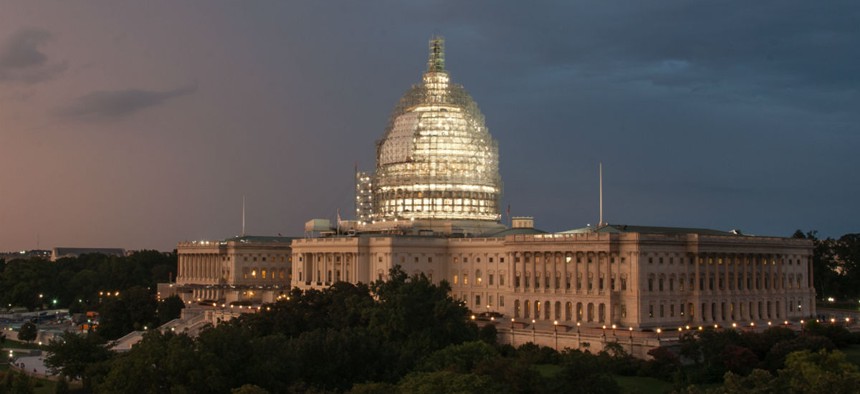The Shutdown Was Avoided, But Agencies Can't Exactly Celebrate
Stopgap funding inhibits long-term planning.
Federal agencies narrowly avoided the catastrophe of a government shutdown this week, but budget experts say they will still feel the pain of congressional stalemates.
President Obama on Wednesday signed a “clean” continuing resolution, a temporary measure to keep agencies funded for 10 weeks at their fiscal 2015 levels. Unlike a full year appropriation, however, the CR does not detail how much agencies should spend on each program or office.
Agencies are expected to spend their funds at the same rates as the previous year, but the lack of a long-term agreement creates uncertainty. Starting new projects is impossible, and spending freely is difficult for agencies awaiting their full year fiscal fates.
“Under a CR, an agency become very conservative,” said John Cooney, formerly deputy general counsel at the Office and Management and Budget and assistant to the solicitor general, and currently at Venable LLP. “It does not want to have spent down all of its funds just to find out Congress won’t” appropriate the amount it expected to receive. Stopgap funding forces agencies to maintain a reserve of resources to plan for any contingencies, Cooney explained, making it difficult for them to plot out their spending over the course of a year.
“They have a big problem planning for spending on that year if the budget isn’t even set until the middle of that year,” said Shai Akabas, the associate director for economic policy at the Bipartisan Policy Center.
Any new projects agencies had been anticipating are delayed, as new spending generally requires direct approval from Congress. Normally, a federal office will have an idea, pitch it to agency leadership, who will try to convince the White House and OMB to include it in its annual budget, and Congress will approve or disapprove it. Under a CR, in which Congress approves nothing besides topline spending levels, that process collapses.
Defense Secretary Ash Carter noted this uncertainty during a Wednesday press briefing.
“It's not enough for our troops [and] not enough for the defense of our country, because this is about more than just the short-term damage of a temporary shutdown,” Carter said. “It's also about the accumulating and lasting damage that comes from a paycheck-to-paycheck approach to budgeting for the defense of our country.”
Carter added the ongoing use of CRs has forced the Pentagon to make painful choices and tradeoffs in the military’s size, capabilities and readiness. A CR is even more difficult for the department, which suffers disproportionately from a lack of sequester relief. Of course, no federal agency will receive their requested funding bump under the stopgap measure that simply renews fiscal 2015’s spending levels.
A CR not only prevents spending on new programs, but also blocks the process of eliminating those that have become wasteful or unnecessary. In a budget of more than $1 trillion, there are initiatives that “either deserve to be, objectively, raised because they are important programs, or reduced because the program is no longer needed,” Akabas said.
Absent the ability to comb through each agency’s funding on a line-by-line basis, Carter said, there is very little oversight of spending.
“Making these kinds of indiscriminate cuts is managerially inefficient and therefore wasteful to taxpayers and industry,” the secretary said. “It's dangerous for our strategy, and frankly, it's embarrassing in front of the world.”
When agencies finally figure out what their full year funding level will be, they have less time to spend any new monies they receive, leading to a rushed and less efficient process. This problem is amplified by the time agencies’ financial gurus have had to spend creating contingency plans for a potential shutdown, which will likely have to be revisited as congressional budget negotiators stretch talks to their new Dec. 11 deadline. Spending decisions made in a confined schedule are “much less efficient than they otherwise would have been,” Cooney said.
Akabas added,” It’s very hard to make rational, long-term decisions for the budget when you’re making decisions at the 11th hour.”
Contractors also feel the pain of unspecified spending, as agencies postpone bids for new contracts and delay renewing existing ones as they await their full year appropriations. This in turn leads to contractors uncertain about planning their own fiscal years, Cooney said.
While continuing resolutions are generally the result of Democrats and Republicans’ failure to reach an agreement on funding levels and unrelated political issues, the areas of agreement -- on where to both cut and boost spending -- are casualties of the process. As agencies await the result of 10 more weeks of congressional bickering, their abilities to deliver government services effectively hang in the balance.
NEXT STORY: Obama Vows Another Try on Gun Regulation




